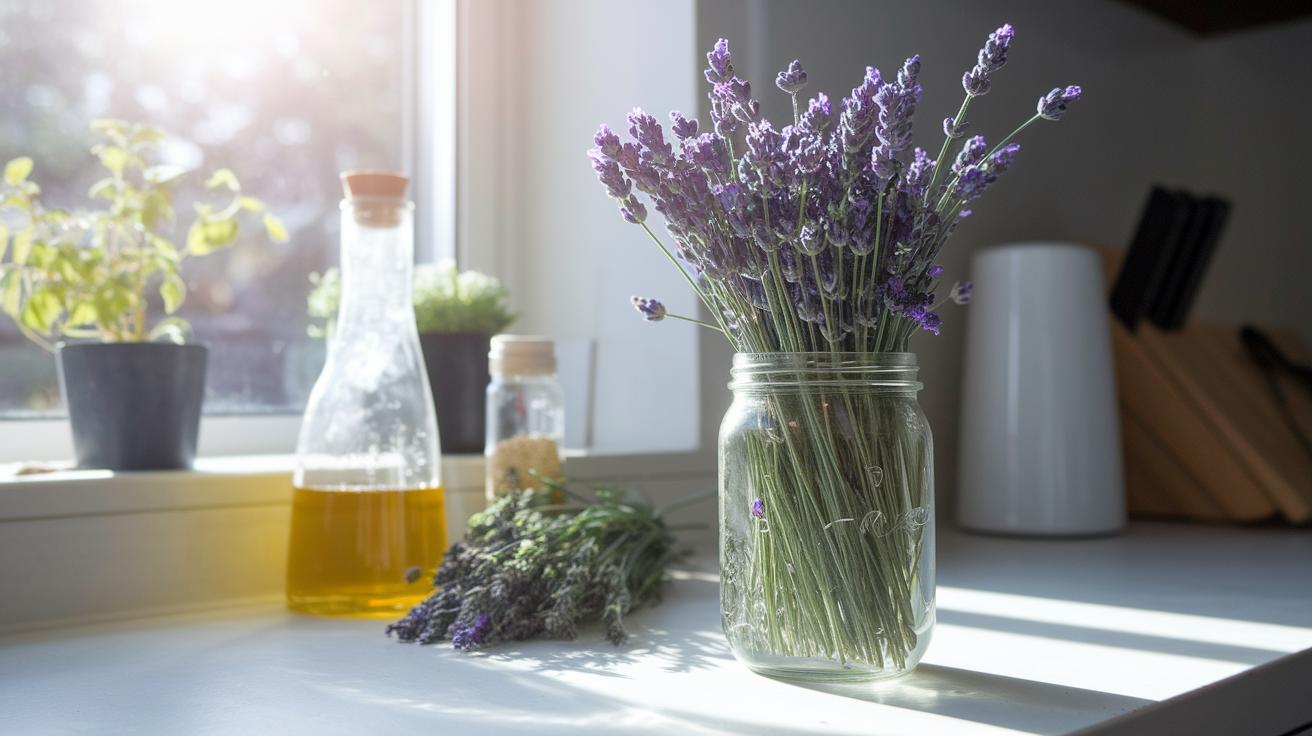Easily Make Organic Lavender Essential Oil with This Joyful DIY Guide!
Have you ever thought making organic lavender essential oil at home requires fancy gadgets? Make Organic Lavender Essential Oil sounds complicated, right? Wait, let me rephrase that. It’s actually simpler than you imagine! You only need dried lavender buds, a carrier oil (neutral oil that carries essential oil to your skin), and a clean jar.
Here’s the thing. We’ll show you how to turn grapeseed oil into a soothing lavender infusion (oil infused with floral extracts). First add three tablespoons of dried buds to the jar. Then pour in enough grapeseed oil to cover them completely.
Seal the jar and place it in a warm, sunny spot. Shake it gently every day. In two weeks the lavender aroma (scent) will fully release. You’ll notice the oil ripples with soft calm.
Taste a drop and you’ll feel how gently soothing it is. This silky infusion is perfect for bedtime rituals, calming massages, or thoughtful homemade gifts. Um, don’t forget to do a skin patch test and keep your oil properly diluted (mixed with carrier oil) to protect your skin.
DIY Guide to Organic Lavender Essential Oil Infusion at Home

Have you ever wanted to capture the soft scent of lavender in an oil? This simple infusion (soaking dried lavender buds in oil) draws out the flower’s gentle antiseptic and calming benefits. You’ll end up with a silky, skin-friendly oil that ripples your senses with every drop. It’s just right for massage blends, bath treats, or natural skin care.
Gather your materials:
- Certified dried lavender buds (English lavender is lovely)
- Cold-pressed grapeseed or sweet almond oil (carrier oil (neutral oil that carries essential oil to skin))
- Clean glass mason jar
- Scissors or clean fingers to crush buds
- Cheesecloth or a fine strainer
- Sunny windowsill or dark cabinet for storage
Here’s how to blend your lavender oil:
- Gently crush the dried buds with scissors or your fingers. This helps release tiny oil pockets and that signature floral aroma.
- Fill the jar halfway with lavender. Then pour in your carrier oil until it sits about an inch below the lid.
- Seal the jar tight. For a solar infusion, set it on a sunny windowsill for one to two weeks. For a cool maceration, tuck it in a dark cabinet for up to four weeks. Give the jar a little shake every day if you’re using dried flowers. You’ll see the oil take on a pale lavender hue.
When your infusion feels just right:
- Strain the mixture through cheesecloth or a fine strainer.
- Press the lavender to get every last drop of fragrant oil.
- Pour the oil into a dark glass bottle.
Store your lavender oil in a cool, dark spot and enjoy its soothing aroma for up to a year. Breathe. Relax.
Selecting and Preparing Organic Lavender Buds
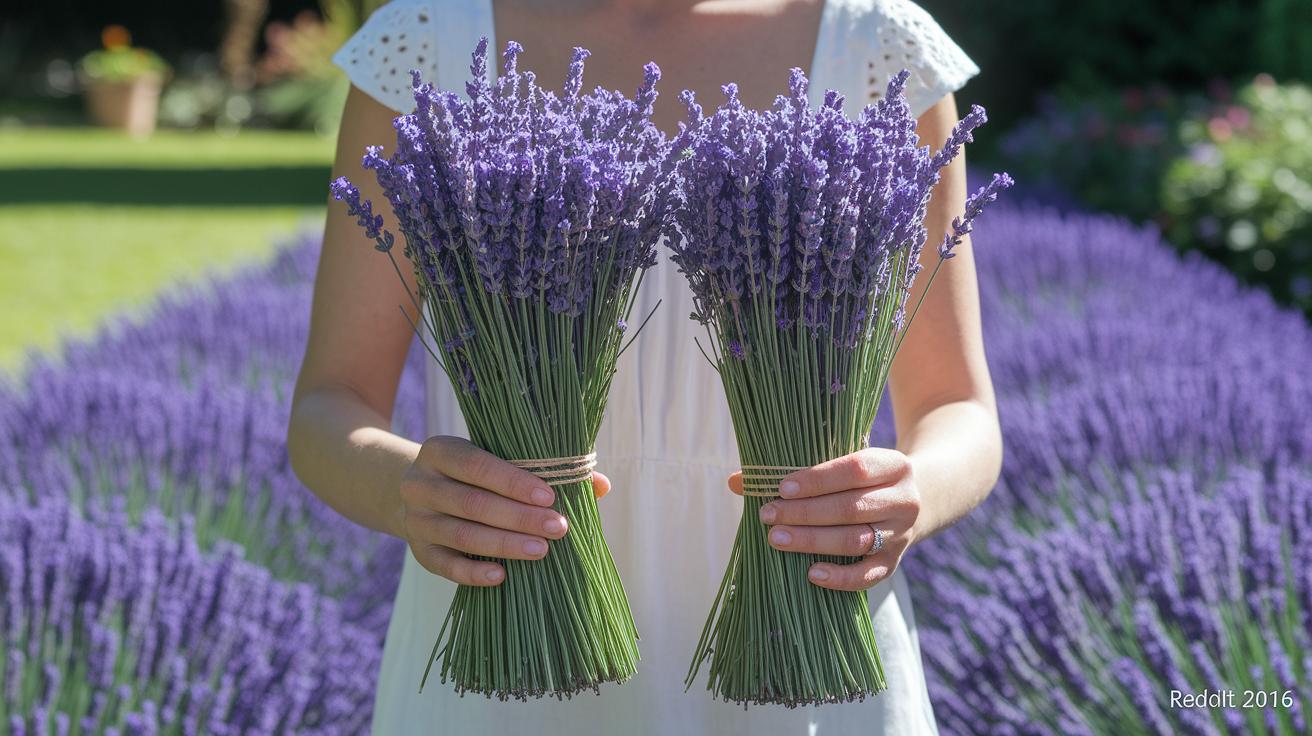
At Organic Aromas, we’re all about pure, soothing scents. Have you noticed how fresh lavender can instantly calm you? Start with certified organic or homegrown lavender buds for the cleanest aroma. English lavender (Lavandula angustifolia, the classic English lavender species) brings a sweet, floral mist and gentle skin-soothing benefits.
But watch out for the Grosso hybrid – it carries more camphor (a minty compound) that can feel sharp or even cause a headache for some.
Next, snip stems just above the first leaves so you capture the flower buds and a bit of stem where the oil pockets are richest. Aim for blooms that are open but haven’t started to fade – they’re at their peak scent. Ah, do the cutting in the morning, just after the sun dries off the dew. That’s when the aroma is most intense.
Then tie small bundles with string and hang them upside down in a dark, well-ventilated spot. Let them dry for seven to ten days until the buds feel crisp. You’ll know they’re ready when a bud snaps clean instead of bending. That means moisture (water content) is under ten percent.
Choosing the Ideal Carrier Oil for Lavender Infusion
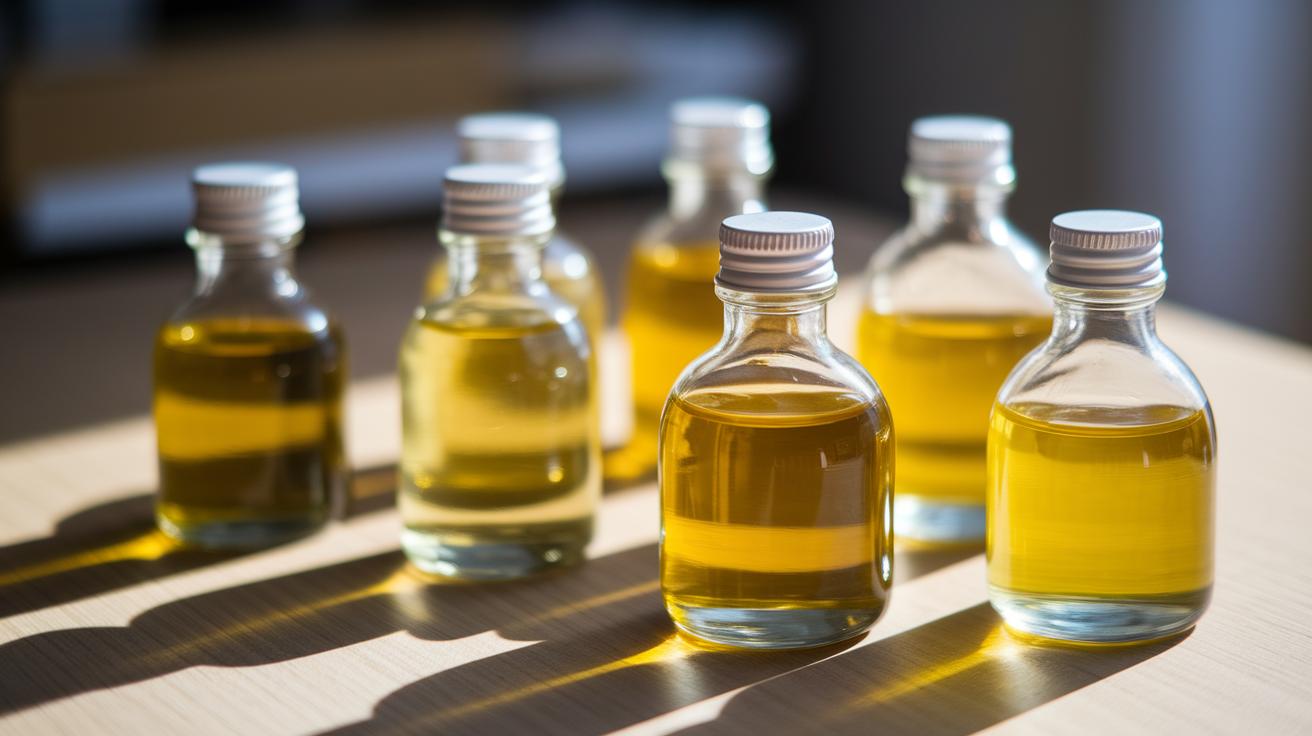
Have you ever wondered how to carry lavender’s gentle scent and skin-loving benefits? Carrier oils dilute lavender’s natural compounds and make each drop soft on your skin. Choose cold-pressed (pressed at low heat) and solvent-free (no chemicals) oils to keep the aroma pure and bright.
Non-comedogenic (won’t clog pores) oils work best for facial blends. Next, explore types of carrier oils for essential oils to find your perfect match.
| Oil Name | Texture | Shelf Life | Best Uses |
|---|---|---|---|
| Extra Virgin Olive Oil | Thick, rich | 18–24 months | Salves, lip balms |
| Sweet Almond Oil | Light, smooth | 12–18 months | Facial oils, body massage |
| Grapeseed Oil | Very light, dry | 12–18 months | Facial blends, acne-prone skin |
| Apricot Kernel Oil | Soft, silky | 12–18 months | Sensitive skin, under-eye serums |
| Fractionated Coconut Oil | Ultra-light, odorless | 24 months+ | Bath oils, full-body massage |
Now think about your goal. For a creamy salve or soap, go with rich olive oil. Want a weightless feel on your face? Pick grapeseed or apricot kernel. If you crave a silky glide in the bath or massage, fractionated coconut oil is your go-to. Breathe. Relax.
Comparing Infusion Techniques: Cold, Solar, and Heat Methods
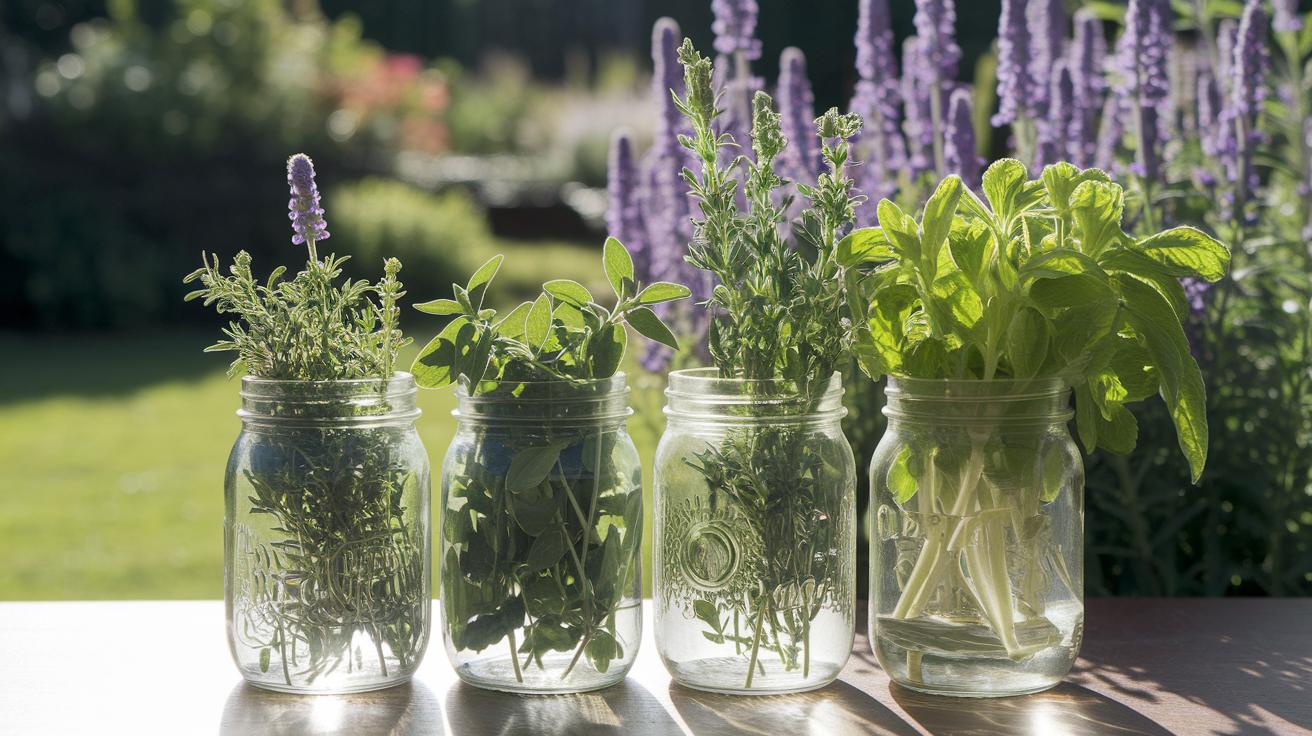
Solar (Cold) Infusion
Have you tried setting a jar of fresh lavender and oil on a sunny windowsill? Over one to two weeks, the gentle sunlight teases out the flower’s fragrant compounds. That’s solar infusion (soaking herbs in oil under sunlight to pull out scent), and all you need is a daily shake to swirl the buds. Soft purple ripples hint at the calm aroma.
Simmering Method
In simmering infusion (using gentle heat to quicken scent release), nestle your jar in a double boiler with water below 120°F so the oil never scorches. Let it steep two to three hours, topping off water as needed. Or switch to a slow cooker on low for three to four hours and walk away. Both methods speed up infusion, though the scent feels a bit softer than solar.
Cold Maceration
Cold maceration (infusion at room temperature) lets time do all the work. Tuck your sealed jar into a dark cabinet for three to four weeks. No daily shaking, just patience as the oil slowly pulls out lavender’s natural goodness. You’ll end up with a rich purple tone and gentle, well-rounded fragrance.
Here’s a quick comparison:
• Solar infusion: 1–2 weeks of sun, bright aroma, pale purple tint.
• Heat infusion: 2–4 hours in a double boiler or slow cooker, quicker but softer scent.
• Cold maceration: 3–4 weeks in a dark spot, balanced color and gentle fragrance.
Filtering, Bottling, and Storing the Infused Lavender Oil
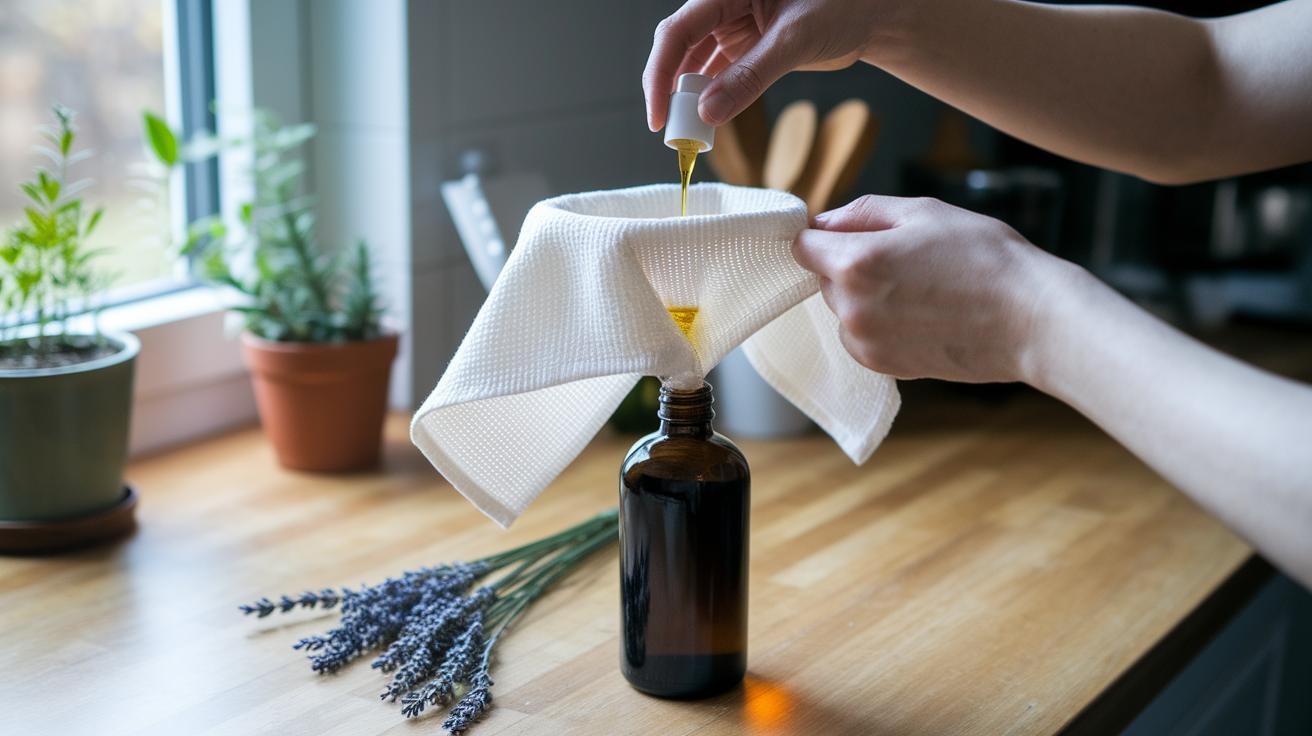
First, set a fine mesh strainer over a clean bowl and line it with cheesecloth (an open-weave cotton cloth that catches tiny herb bits). Pour your lavender-infused oil through the layers. Gently twist the cloth so every golden drop ripples out. Discard the spent lavender buds.
Next, decant the warm oil into sterile amber or dark glass bottles (dark glass protects that soft lavender aroma). Label each bottle with the infusion date and the carrier oil you used. Store them in a cool, dark cabinet. Your lavender-infused oil will stay fresh for up to a year without added antioxidants, no need if you’ve begun with a top-quality carrier oil.
Safety Considerations and Practical Uses for Organic Lavender Infusion

Safety Guidelines
At Organic Aromas, our Lavender Infusion is all about pure calm and a clean scent. But safety comes first. Always start with a patch test (a small allergy check). Mix two to five drops of the infusion with a teaspoon of carrier oil (a mild plant oil that helps spread the lavender infusion) and dab it on your forearm.
Wait 24 hours to make sure your skin stays calm. And don’t ever eat oil made from fresh lavender. Fresh blooms hold moisture that can cause mold. For cooking, only use oil infused with dried lavender. Finally, tuck your bottles in a cool, dark spot so they stay fresh and fragrant.
Topical and Aromatherapy Uses
Lavender Infusion shines in skin routines and moments of calm. It helps you pause and breathe. And it smells like a fresh lavender field.
Blend three drops into your daily moisturizer to soothe redness and enjoy a soft floral aroma, check out organic lavender essential oil for skin care benefits. Then stir ten drops into a tablespoon of carrier oil for a massage that eases tension and mild aches.
Next, float eight drops in a warm bath and breathe in the gentle mist as it circles your space.
For bedtime bliss, add three to five drops to a spray bottle for a DIY pillow mist or diffuser blend. It’s like tucking yourself under a lavender cloud. You can even mix in a drop of lemon or rose oil to boost stress relief.
And for a quick moment of calm, rub a drop around your temples. Breathe. Relax.
Make Organic Lavender Essential Oil Infusion at Home
You’ve learned why an oil infusion brightens your self care and brings gentle calm.
We covered picking dried organic lavender buds, choosing a light carrier oil like grapeseed or almond, and gathering simple tools like a glass jar, scissors and cheesecloth.
Then you saw step by step maceration methods in a sunny spot or dark room. You also got tips on shaking, straining and bottling your aromatic oil.
Now you’re set to use what you learned on how to make organic lavender essential oil infusion at home and enjoy that spa-like scent in your daily routine, naturally uplifting your mood.
FAQ
How do you make lavender oil infusion at home?
Making lavender oil infusion at home uses dried lavender buds and a carrier oil. Fill a glass jar halfway with buds, top with cold-pressed oil, seal, and steep in sunlight or a dark spot for 1–4 weeks, shaking daily.
How do you make lavender oil quickly?
Making lavender oil quickly involves a stovetop or slow cooker method. Combine dried buds and carrier oil in a double boiler or low-heat slow cooker under 120 °F for 2–4 hours, stirring occasionally before straining.
How do you make lavender essential oil without a still?
Making lavender essential oil without a still yields an infused oil, not a pure essential. Use dried buds and carrier oil in a sealed jar, then steep for 1–4 weeks in sun or darkness, shaking daily before straining.
What is the best carrier oil for lavender oil?
The best carrier oil for lavender oil depends on how you plan to use it. Grapeseed and sweet almond offer a light texture, fractionated coconut suits bath blends, and apricot kernel or avocado works well for facial skin.
Can you infuse fresh lavender?
Infusing fresh lavender requires extra weight to keep buds submerged and a shorter steep time. Store in a dark spot for 1–2 weeks to avoid mold, shaking gently each day before straining.
How long does infused lavender oil last?
Infused lavender oil lasts up to one year when stored in a cool, dark place inside amber glass bottles. For best scent and benefits, plan to use it within 6–9 months of bottling.
How do you make lavender oil for skin?
Making lavender oil for skin uses dried buds and non-comedogenic carrier oils like sweet almond or apricot kernel. Infuse in a dark spot for 3–4 weeks, strain well, and perform a forearm patch test before applying.

